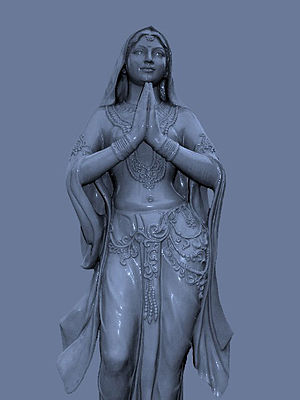Note: This is a project under development. The articles on this wiki are just being initiated and broadly incomplete. You can Help creating new pages.
Difference between revisions of "Añjali Mudrā"
Chaithrika (talk | contribs) |
Chaithrika (talk | contribs) |
||
| Line 24: | Line 24: | ||
| − | [[Category: | + | [[Category:Mudras]] |
Revision as of 11:17, 5 December 2016
Añjali Mudrā (Sanskrit: अञ्जलि मुद्रा) or praṇāmāsana (Sanskrit: प्रणामासन) is a hand gesture which is practiced throughout Asia and beyond. It is used as a sign of respect and a greeting in India, Sri Lanka, Nepal, Bhutan, Thailand, Cambodia, Laos, Burma, Indonesia, and amongst yoga practitioners and adherents of similar traditions.The gesture is incorporated into many yoga asanas. The gesture is also used for worship in many Eastern religions.
Anjali mudra is performed by pressing the palms of the hands together. The fingers are together with fingertips pointing up. The hands are pressed together firmly and evenly.
In the most common form of anjali mudra, the hands are held at the heart chakra with thumbs resting lightly against the sternum. The gesture may also be performed at the Ajna or brow chakra with thumb tips resting against the "third eye" or at the crown chakra (above the head). In some yoga postures, the hands are placed in anjali mudra position to one side of the body or behind the back.
Anjali mudra is normally accompanied by a slight bowing of the head.
Symbolic meaning
- Anjali mudra has the same meaning as the Sanskrit greeting Namaste and can be performed while saying Namaste or Pranam, or in place of vocalizing the word.
- The gesture is used for both greetings and farewells, but carries a deeper significance than a simple "hello" or "goodbye". The joining together of the palms is said to provide connection between the right and left hemispheres of the brain and represents unification or "yoking". This yoking is symbolic of the practitioner's connection with the divine in all things. Hence, performing anjali mudra is an honouring of both the self and the other as the gesture acknowledges the divinity of both practitioner and recipient.
- In Sri Lanka the Sinhalese gesture of welcome incorporates the words "ayubowan" (may you live long) with both hands placed together on the sternum with a slight bow.
Physical benefits
- Anjali mudra is performed as part of a physical yoga practice with an aim to achieving several benefits. It is a centering pose which helps to alleviate mental stress and anxiety and is therefore used to assist the practitioner in achieving focus and coming into a meditative state.
- The physical execution of the pose helps to promote flexibility in the hands, wrists, fingers and arms.
